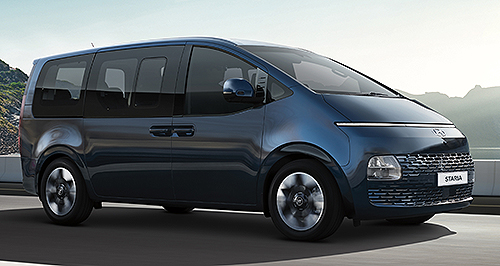Make / Model Search
New models - Hyundai - StariaHyundai launches new Staria MPV from $48,500Staria replaces Hyundai’s ancient iMax with Santa Fe platform and futuristic styling6 Aug 2021 By NEIL DOWLING HYUNDAI has jumped headfirst into the people mover segment, discarding its van-based iMax eight-seater to next month launch its futuristically-styled SUV-based Staria.
The new model, based on the Santa Fe platform, is touted as an alternative to an SUV and will hit the market to shirt-front its sibling, the Kia Carnival, which has long held the lion’s share of the sub-60,000 people mover segment – 60 per cent so far this year-to-date.
Three grades will be offered from launch – Staria, Elite and Highlander – with the range kicking off from $48,500 plus on-road costs.
Two engines will be offered locally – a 3.5-litre petrol V6 (200kW/331Nm) driving the front wheels, and an all-wheel-drive 2.2-litre turbo-diesel (130kW/430Nm) – with each paired to an eight-speed automatic transmission.
Despite being the same engines, the power outputs of both units are down on those of the Carnival which develops 216kW/355Nm in petrol form and 148kW/440Nm in diesel guise.
Externally the new Hyundai is as evocative as the Toyota Tarago “egg” of 1990. It has a similar “one-curve silhouette” and rounded, bonnetless nose.
The Staria uses low-set LED headlights and a barely perceptible front air intake, with a horizontal LED strip for the daytime running lights.
At the back, it has a large glass area with an integrated ‘Staria’ logo and vertical LED tail lights rising to a spoiler with an integrated high-mount stop light.
Hyundai Motor Company Australia (HMCA) chief executive officer Jun Heo said the Staria would provide customers with an alternative to the seven-seat Santa Fe and eight-seat Palisade SUVs “with all the safety, comfort and convenience technology customers expect in a modern passenger vehicle”.
Under that futuristic skin, the Staria rides on a stretched version of the Santa Fe platform with 508mm being added to the wheelbase which now measures 3273mm – longer than both the Palisade (2900mm) and the Carnival (3090mm).
The new Hyundai promises seating for eight and luggage space of 831 litres with all seats upright. This compares well with the Carnival’s 627 litres, even if the Kia is 98mm shorter overall.
Cabin features include a boarding step and a ‘walk-in device’ sliding function for the second row which creates up to an extra 100mm of foot clearance for easy third row access.
Second and third row sunshades give rear passengers – particularly children and babies – the option to block out glare and heat.
In terms of upholstery, the base Staria comes with black cloth as standard with the Elite stepping this up with black leather before the Highlander trumps them both with the choice of blue or beige leather as well as front and rear sunroofs as standard.
Hyundai has loaded its new people mover full of technology, starting with its “cruise-ship inspired” interior highlighted by two 10.25-inch displays (depending on the grade); one for the satellite navigation and the multimedia system, and one for the full-digital, virtual instrument cluster.
Other spec highlights include sliding and folding seats, wireless smartphone charger, five USB charging ports, ‘smart key’ push-button and remote start, 16 cup holders, electric sliding side doors and a powered tailgate.
Safety equipment opens with blind-spot monitoring, surround-view cameras, rear passenger view monitor and seven airbags including a front-centre side airbag.
There are also standard forward-collision avoidance (autonomous emergency braking) assist functions built into the blind-spot, rear cross-traffic and junction-turning systems.
Other safety items available include high-beam assist, lane-keeping warning and assist, lane-following assist, smart cruise control with ‘stop and go’, safe-exit assist, rear occupant alert, driver attention warning and leading-vehicle departure alert.
Diesel versions use Hyundai’s in-house developed HTRAC AWD system, something of a USP within this segment – you actually have to look in the next segment up to find an all-paw rival in the form of the AWD Volkswagen Multivan which costs $13,400 more than the Staria.
HTRAC has an electronic, variable clutch that apportions torque between the front and rear axles and can vary the torque distribution between left and right wheels by applying braking to the opposite wheel, based on inputs from vehicle speed and other sensors.
It also has a centre differential lock to distribute power evenly to all four wheels in off-road situations.
While MPVs are not known for their towing abilities, Hyundai says the new model can tow up to 2500kg (braked), further adding to its versatility in the case of the diesel.
Five colours will be available, those being ‘abyss black’, ‘moonlight blue’, ‘gaia brown mica’, ‘graphite grey’ and ‘olivine grey’.
2022 Hyundai Staria pricing*
*Excludes on-road costs  All new models Alfa Romeo Alfa Romeo Abarth Abarth Alpine Alpine Alpina Alpina Audi Audi Aston Martin Aston Martin BMW BMW Bentley Bentley Chery Chery Brabham Brabham Chrysler Chrysler Chevrolet Chevrolet Cupra Cupra Citroen Citroen DS DS Dodge Dodge Fiat Fiat Ferrari Ferrari Foton Foton Ford Ford Great Wall Great Wall FPV FPV Haval Haval GWM GWM Honda Honda Holden Holden Hyundai Hyundai HSV HSV Isuzu Isuzu Infiniti Infiniti Jeep Jeep Jaguar Jaguar Lamborghini Lamborghini Kia Kia LDV LDV Land Rover Land Rover Lotus Lotus Lexus Lexus Maserati Maserati Mahindra Mahindra McLaren McLaren Mazda Mazda Mercedes-Benz Mercedes-Benz Mercedes-AMG Mercedes-AMG Mini Mini MG MG Nissan Nissan Mitsubishi Mitsubishi Pagani Pagani Opel Opel Porsche Porsche Peugeot Peugeot Ram Ram Proton Proton Rolls-Royce Rolls-Royce Renault Renault Saab Saab Rover Rover Smart Smart Skoda Skoda Subaru Subaru SsangYong SsangYong Tesla Tesla Suzuki Suzuki Toyota Toyota Volvo VolvoMotor industry news |
|









Facebook Twitter Instagram